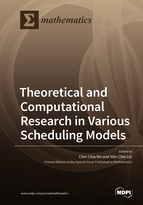Theoretical and Computational Research in Various Scheduling Models
A special issue of Mathematics (ISSN 2227-7390). This special issue belongs to the section "Engineering Mathematics".
Deadline for manuscript submissions: closed (31 December 2021) | Viewed by 17082
Special Issue Editors
Interests: algorithms; production engineering; scheduling; industrial engineering; operations research; optimization algorithms
Special Issues, Collections and Topics in MDPI journals
Interests: combinatorial optimization; algorithm development
Special Issues, Collections and Topics in MDPI journals
Special Issue Information
Dear Colleagues,
The long-standing field of research with great practical value in operation research involves designing effective methods to find the best solution to perform certain jobs or policies with or without certain constraints. The literature shows that numerous papers have been written on scheduling theory and its applications over a long time. To solve various scheduling problems in different real-life environments, the literature also assesses many studies on developing exact methods or approximate algorithms, through deriving computational complexity, or evaluating their performance by using simulation results.
However, there are a lot of challenging scheduling problems in new application domains which have yet to be further explored. Thus, scheduling issues have always been a popular field of research, with many potential real-life applications including assignment, manufacturing, and logistics.
This Special Issue aims to provide a bridge to facilitate the interaction between the researcher and the practitioner in scheduling questions. Although discrete mathematics is a common method to solve scheduling problems, the further development of this method is limited due to the lack of general principles, which poses a major challenge to this research field. Papers that have made significant contributions to methodological progress or created model innovations to solve major and well-documented scheduling problems are welcome. The studies can be theoretical, methodological, computational, or application-oriented. In addition, relevant statistical applications in social systems are also welcome. Potential topics include but are not limited to the following:
- Scheduling in flow shops, open shops, or job shops settings
- Scheduling on parallel machines or in assembly flow shop
- Scheduling in green manufacturing environment
- Scheduling with multiple competing agents
- Scheduling in intelligent logistics
- Scheduling in time-dependent processing times
- Statistical methods application to engineering or relevant disciplinary
Prof. Dr. Chin-Chia Wu
Prof. Dr. Win-Chin Lin
Guest Editors
Manuscript Submission Information
Manuscripts should be submitted online at www.mdpi.com by registering and logging in to this website. Once you are registered, click here to go to the submission form. Manuscripts can be submitted until the deadline. All submissions that pass pre-check are peer-reviewed. Accepted papers will be published continuously in the journal (as soon as accepted) and will be listed together on the special issue website. Research articles, review articles as well as short communications are invited. For planned papers, a title and short abstract (about 100 words) can be sent to the Editorial Office for announcement on this website.
Submitted manuscripts should not have been published previously, nor be under consideration for publication elsewhere (except conference proceedings papers). All manuscripts are thoroughly refereed through a single-blind peer-review process. A guide for authors and other relevant information for submission of manuscripts is available on the Instructions for Authors page. Mathematics is an international peer-reviewed open access semimonthly journal published by MDPI.
Please visit the Instructions for Authors page before submitting a manuscript. The Article Processing Charge (APC) for publication in this open access journal is 2600 CHF (Swiss Francs). Submitted papers should be well formatted and use good English. Authors may use MDPI's English editing service prior to publication or during author revisions.
Keywords
- scheduling
- multiple-agent
- time-dependent processing times
- assignment
- statistical method






